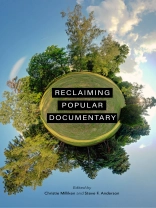The documentary has achieved rising popularity over the past two decades thanks to streaming services like Netflix and Hulu. Despite this, documentary studies still tends to favor works that appeal primarily to specialists and scholars.
Reclaiming Popular Documentary reverses this long-standing tendency by showing that documentaries can be—and are—made for mainstream or commercial audiences. Editors Christie Milliken and Steve Anderson, who consider popular documentary to be a subfield of documentary studies, embrace an expanded definition of popular to acknowledge the many evolving forms of documentary, such as branded entertainment, fictional hybrids, and works with audience participation. Together, these essays address emerging documentary forms—including web-docs, virtual reality, immersive journalism, viral media, interactive docs, and video-on-demand—and offer the critical tools viewers need to analyze contemporary documentaries and consider how they are persuaded by and represented in documentary media.
By combining perspectives of scholars and makers, Reclaiming Popular Documentary brings new understandings and international perspectives to familiar texts using critical models that will engage media scholars and fans alike.
Tabela de Conteúdo
Acknowledgments
Part I: Popular Documentary Today
1. Pop Docs: The Work of Popular Documentary in the Age of Alternate Facts, by Christie Milliken and Steve F. Anderson
2. Reclaiming the Popular for Public Interest Documentary, by Ezra Winton
Part II: Documentary Ecologies
3. Public Television’s Role in the U.S. Documentary Ecology, by Patricia Aufderheide
4. On (Not) Falling from the Sky: Fly-Over Global Documentary as Capitalist Body Genre, by Zoë Druick
5. Accelerating Deceleration: Slow Violence and Time-Lapse Cinematography, by Devon Coutts
Part III: Short Forms and Web Practices
6. From Elegy to Kitsch: Spectacles of Epistephelia in Food, Inc. and Early Food Documentaries, by Sabiha Ahmad Khan
7. Errol Morris, The New York Times, Docmedia, and Op-Docs as Pop Docs, by Anthony Kinik
8. Popular Music & Short Form Nonfiction: Is the Web a Forum for Documentary Innovation?, by Michael Brendan Baker
Part IV: Auteurs, Politics and Popularity
9. From the Essay Film to the Video Essay: Between the Critical and the Popular, by Allison de Fren
10. Errol Morris and the Ends of Irony, by Jonathan Kahana
11. Vérite: Lauren Greenfield and the Challenge of Feminist Documentary, by Shilyh Warren
Part V: Documentary Genres
12. Citizenfour and the Anti-Representational Turn: Aesthetics of Failure in the Information Age, by S. Topiary Landberg
13. Of Kids and Sharks: Victims, Heroes and the Politics of Melodrama in Popular Documentary, by Christie Milliken
14. Strategies of the Popular Music Documentary’s Recovery Mode, by Landon Palmer
Part VI: Engaging Audiences
15. Assembling Nanking: Archival Filmmaking in the Popular Historical Documentary, by Dylan Nelson
16. Virality is Virility: Viral Media, Popularity and Violence, by Alexandra Juhasz
17. Populism, Participation and Perpetual Incompletion: Performing an Urban History Commons, by Rick Prelinger
18. The Armchair Juror: Audience Engagement in True Crime Documentaries, by George S. Larke-Walsh
19. New (Old) Ontologies of Documentary, by Steve F. Anderson
Index
Sobre o autor
Christie Milliken is Associate Professor in the Department of Communication, Popular Culture and Film at Brock University. She is author of journal articles and book chapters on sex education film and video, 1960s cinema, and AIDS video activism. Steve F. Anderson is Professor of Digital Media in the UCLA School of Theater, Film and Television and in the Department of Design Media Arts. He is author of Technologies of History: Visual Media and the Eccentricity of the Past and Technologies of Vision: The War Between Data and Images.












